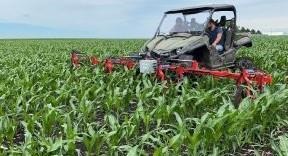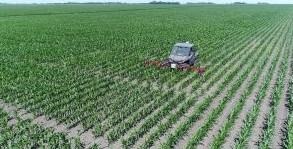By Sarah Hays
After over a decade of work, Iowa State University Department of Agricultural and Biosystems Engineering professor Lie Tang has fine-tuned and developed a machine to automate phenotype measurements of crops in fields.

PSA implemented on Syngenta’s auto-steer UTV platform
With the ability to count eight rows of corn crops at a time, this machine measures crops like corn at the rate of 40 tireless people – and with a higher level of accuracy than what the average person can retrieve. Known as the Plant Stand Analyzer (PSA), this machine points a stack of laser sensors at each crop plant in all eight rows, and if the laser sensors register a crop plant, the algorithm on the computer can detect it – and scientists can count the number of crop plant, also known as stand count, in the rows in real-time, at a speed of up to 10 miles per hour. Tang invented this machine at Iowa State, and licensed the technology from the Iowa State University Research Foundation. After licensing, Tang started a small business called ‘FieldRobo LLC,’ dedicated to the production of devices like the Plant Stand Analyzer. The PSA won the 2019 AE50 Award that represents the best innovations in engineering and technology for agricultural, food, and biological systems.
This machine alters what phenotype measurements are known to be today – saving time and money in the field.
“In the past, if you wanted to acquire data of plants, like stand count, stem diameter, plant height, leaf angle, leaf area, etc., you would have to go into the field and measure them by hand,” Tang said. “That really has become a bottleneck for plant breeding and plant phenomics research. Now, someone can drive a machine like the PSA in the field, and then you can register the data from the lasers. Every millimeter is measured, creating a profile of each crop row.”
Since the PSA calculates whether the crop plant is there or not, it can seem like it would be easy to accidentally log a weed or other variables as a crop plant. But the machine is so intricate that most times it can determine if it is a normal corn plant, a weed plant, a corn plant with tillers, also known as plants with extra shoots, or double-seeded plants. Currently there are 56 high-speed laser sensors on the analyzer, seven that collect data from each row. Once the laser beams hit a crop plant in front of a sensor bank, the lights reflect off of the crop plant and bounces into the sensors, and this reflectance is captured 3 times within each millimeter that PSA traveled.

PSA in a large-scale operation
This can be extremely valuable to seed companies that count their seed germination rates when they are planted, but don’t have a plethora of technology to see how the seeds develop.
“When seed companies plant research plots, they know how many seeds they are putting in the ground,” Tang said. “But depending on the genetics and other factors, not all the seeds will germinate. They want to have a good quality control of the data generated. Also, if they don’t know how many plants are contributing to the yield, their final data analysis is skewed.”
But now, this machine can show how many plants grow in each row. As the analyzer gathers data, scientists see each crop plant represented as a green circle on the computer screen, sorted by row, which will also be organized into plots automatically by a customized mapper software. The Plant Stand Analyzer not only produces stand count, but also a collection of other useful metrics such as stalk size, interplant spacing, gaps, doubles and tillers – which no other high-throughput system can provide as of today.
“While the Plant Stand Analyzer is highly robust and successful, there are some competing technologies in the field. But when considering the large-scale performance, the main competition is from the drone-based systems. However, the PSA offers some distinctive advantages in its fast data-to-information turn-around-time (the same day), superior stand detection accuracy (97% on average), a large operational time window (3-4 weeks), and no special license required to operate the system,” Tang said.
In the future, this sensing technology could be used in other ways, from analyzers to many different devices used to gather crop data and to give treatments to crop plants individually.
“With this sensor technology used in the PSA, we can detect individual plants in on-the-go. Imagine you have that sensor paired with something like a fertilizer applicator, you could regulate the amount of spray and only fertilize when there is a plant in presence and save chemicals.”
To tackle the many challenges in field-based plant phenotyping, and as one of the Plant Sciences Institute faculty scholars at ISU, Tang has been working closely and proactively with plant scientists and plant seed industry to develop robotic solutions, such as his ongoing effort in developing a PhenoBot that will be capable of acquiring a sophisticated set of traits through 3D vision, machine learning and robotic manipulations.
Source : iastate.edu